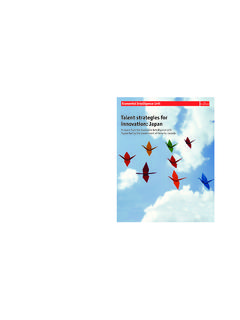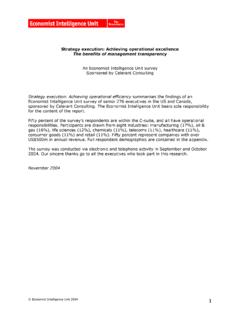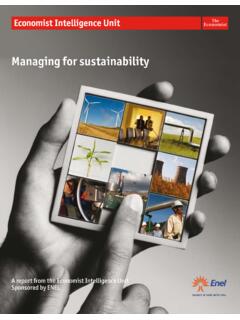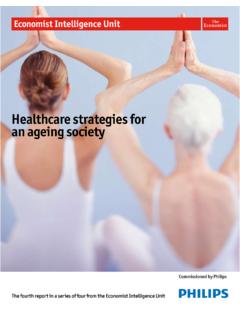Transcription of The GCC in 2020: Resources for the future
1 The GCC in 2020: Resources for the futureA report from the Economist Intelligence Unit Sponsored by the Qatar Financial Centre AuthorityThe GCC in 2020: Resources for the future The Economist Intelligence Unit Limited 20101 ForewordOver the next decade, as the GCC population soars by 30% to over 50m people, the Gulf region will see an increasing strain on its supplies of electricity, food and water. The ways in which the region faces up to these challenges will have a major impact on its prosperity and quality of life, not only in 2020 but in the decades to come. This report addresses the outlook for these key Resources in the next decade, and explores policy options to ensure that supply keeps up with demand. The report also addresses the challenges in carrying out such policies, including funding massive new infrastructure and shaping public attitudes to encourage conservation.
2 Many of these challenges are well known to the region s governments, which have already started to take the needed steps. While much remains to be done, the young populations and significant capital Resources of the GCC states are key GCC in 2020: Resources for the future is a research paper written by the Economist Intelligence Unit. It was sponsored by the Qatar Financial Centre (QFC) Authority in the interest of promoting informed debate. The Economist Intelligence Unit bears sole responsibility for the content of this report. The author was Jane Kinninmont and the editor was Aviva findings are based on two strands of research:l Analysis of resource requirements and supplies, drawing on Economist Intelligence Unit data and other data A programme of in-depth interviews with economists, academics and other leading experts in the region s resource requirements.
3 The participants in the in-depth interview programme are listed in the Appendix to this report. Our sincere thanks go to all interviewees for sharing their insights on this GCC in 2020: Resources for the future The Economist Intelligence Unit Limited 20102 The member countries of the Gulf Co-operation Council (GCC, consisting of Qatar, the UAE, Kuwait, Bahrain, Saudi Arabia and Oman) are expected to post robust growth over the next decade both in terms of population and GDP. By 2020 the GCC population is forecast to reach , a 30% increase over the level in 2000. Over the same period, the region s real GDP is expected to grow by 56%. Nominal GDP, which was US$ in 2000, is forecast to soar to over US$1trn in 2010 and US$2trn in the economic forecast is positive, it carries a risk: that unmanaged growth will bring negative side-effects such as power shortages and soaring prices, in particular for food.
4 Some GCC states are already experiencing sporadic shortages of electricity and gas, while water supplies are already strained and food shortages loom as risks for an import-dependent region. A key challenge for the Gulf in the next decade therefore will be to manage energy, water and food Resources to ensure both high living standards and sustainable growth in the long term. Aware of these challenges, Gulf Arab states are undertaking a variety of measures to ensure long-term sustainable growth. These include:l introducing energy-efficiency measures;l investing in clean fuel and renewable energy supplies;l improving water efficiency;l investing in new water desalination capacity; andl buying or leasing agricultural land governments have recognised the challenges involved in boosting resource supply security in the long term, much remains to be done to ensure the success of policy initiatives.
5 For example, public attitudes towards energy and water conservation including curtailment of subsidies remain resistant to change. New infrastructure to produce water and electricity require massive additional investment. Political controversies arising from investment in farmland abroad require continued management. Despite these challenges, however, the GCC states have a positive outlook for long-term security of key Resources , as their young populations and significant capital Resources create good conditions for implementing the necessary summaryThe GCC in 2020: Resources for the future The Economist Intelligence Unit Limited 20103 GCC states look beyond their present-day fossil fuel richesGiven the GCC s huge oil and gas deposits, energy conservation may look to be unnecessary.
6 After all, global demand for oil and gas will continue to grow, as rising demand in emerging markets will offset stagnant demand in the OECD. At the same time, non-OPEC supply growth is likely to slow down, and the development of Iraqi and Iranian capacity is likely to be held back by political factors. The GCC countries, meanwhile, control 40% of the world s known oil reserves and 23% of proven natural gas reserves. World dependency on GCC energy exports will grow by 2020. In the circumstances, why should the GCC worry about conserving energy Resources ? Yet conserve it must not only because hydrocarbon Resources are finite, but because conservation makes financial sense. Demand for electricity, which is typically generated by domestic gas, is already outstripping supply in the GCC.
7 Fast population growth threatens to create acute shortages unless something is done. Moreover, using fossil fuels to generate electricity means having less available for export, which in turn means high opportunity these factors in mind, the GCC governments are starting to overhaul the way they manage their oil and gas. In particular, most are trying to rein in wasteful domestic consumption of electricity and gas. They plan to continue exporting oil as crude, but to reserve a greater proportion of the crude to manufacture value-added refined products, such as petrochemicals and plastics, for export. With the exception of Qatar s plans to export liquefied natural gas (LNG), the region s governments will use natural gas mainly to fuel domestic power plants.
8 They will also invest more in developing cleaner fuels, both in response to global concerns about carbon emissions and as a way to supplement fuel supplies for domestic of this represents a forward-thinking approach to solving a problem that is only beginning to emerge. The GCC has substantial fossil fuel reserves, but it cannot be complacent about its long-term supply advantage. Other regions are investing heavily in alternative fuels and in fuel efficiency, as well as in developing previously untapped oil and gas reserves, thus creating potential competitors for GCC example, the Gorgon gasfield found in Australia in 2009, with an estimated 40 trn cu ft in reserves, added some to the world s known natural gas reserves, and it is much closer to key Part 1: EnergyThe GCC in 2020: Resources for the future The Economist Intelligence Unit Limited 20104 Asian markets than the GCC.
9 Another example is the discovery of shale gas in the US in the past two years. Before this discovery, the Gulf states had assumed that their cheap gas would not only give their national industries a push, but it would help to attract foreign direct investment from international companies and help them to obtain technology transfer, notes Justin Dargin, research fellow at Harvard University s Dubai Programme. Three years ago, the cost of buying gas in the US was about US$13 per million Btu compared with US$1 per million Btu in the Gulf. But the shale gas that s been found may stop the Gulf from being so competitive. GCC governments are aware that they must prepare for a world of increased competition in energy markets. This is blunting some of the traditional resistance in the region to developing alternative energy sources.
10 Rather than perceiving such fuels as threats to their markets measures that either reduce demand or offer substitutes for fossil fuel exports many in the region are starting to see these technologies as part of an unstoppable global trend, and one from which they could actually benefit if they develop competitive technologies diversification boosts demand for oil and gas as feedstockDespite their fossil fuel riches or perhaps because of it GCC states are trying to diversify away from dependence on oil and gas. The aims of diversification are to reduce the region s long-term vulnerability to shifts in international demand, to create jobs for GCC nationals in more knowledge-intensive industries, and to prepare for the eventual transition to a post-hydrocarbons economy.









